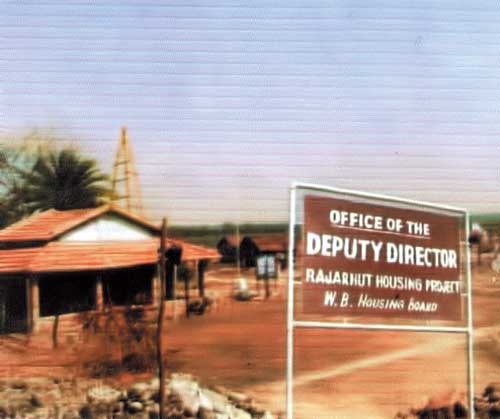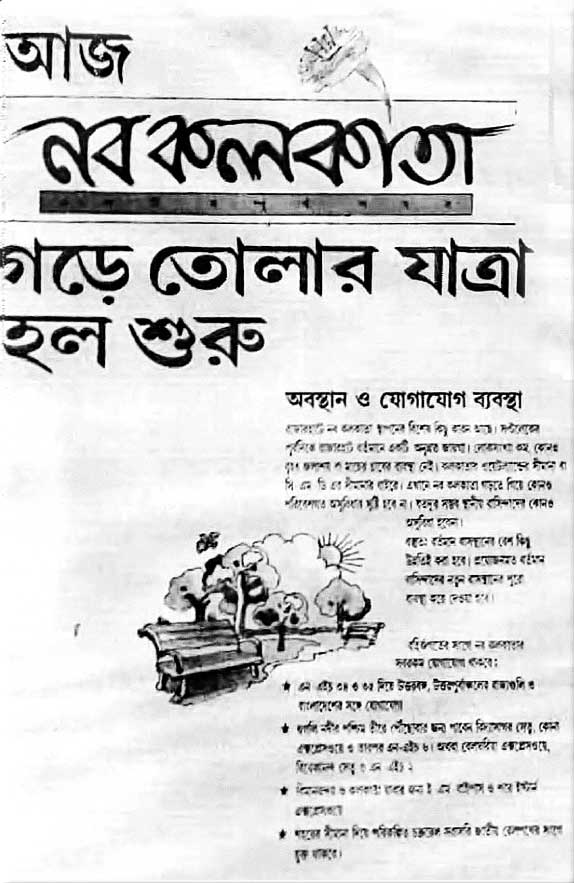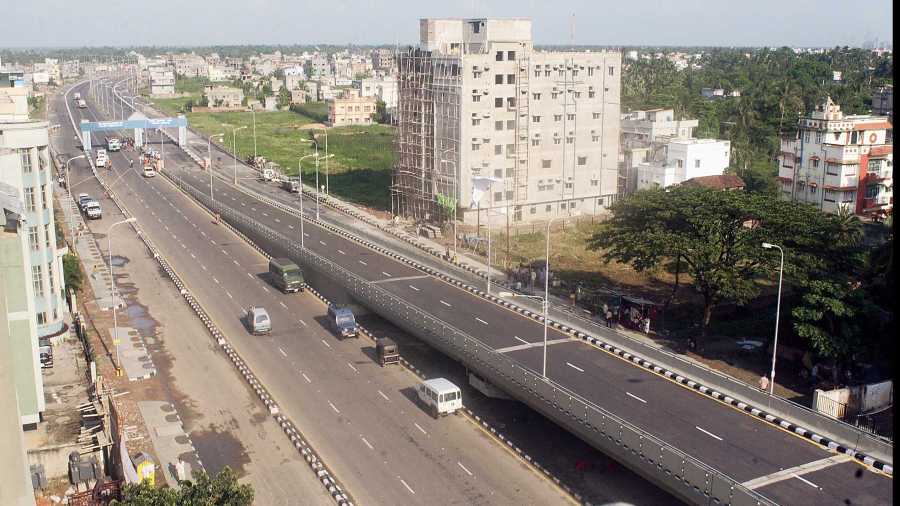The people of Bengal are not new to greenfield township projects, already having the experience of earlier greenfield town development projects like Bidhannagar, Kalyani, Durgapur and Haldia.
But New Town is fundamentally different from these earlier projects. It is now being estimated that to complete this township at the present price-value, the government, the Housing Infrastructure Development Company (Hidco) and other stakeholders like several public sector companies, joint venture companies, co-operatives and individuals would have jointly incurred an expenditure of about nearly one lakh crore rupees.
Self-sustaining model
Another challenging decision taken by Hidco was not to depend on the state government’s budgetary provisions and allocations but to ensure that the project was completed on a self-sustaining model — on a no-loss no-dividend basis. We had also made it clear that if indeed HIDCO could make some profit, it would entirely be used for the good of the public and disseminated among the members of the society.
The Herculean task of building a new township and that too as a complete greenfield project, without being financed by on-budget provisions of the government and mobilising land of approximately 3,770 hectares, big enough to contain nearly one and a half million residential and floating day time population respectively, had been taken up and pursued without much fanfare and publicity. Nevertheless, all key stake-holders were taken into confidence...
In retrospect, I believe it was this participatory style of collective leadership, team functioning and contribution of the people as well, that helped us to develop New Town within a relatively short time span...
The location of this township was accidentally stumbled upon...
Light in the horizon
One evening I was returning from Basirhat through the rural stretches of Beliaghata.I had taken the Martin Burn Road also colloquially known as the 211 road (211 being a bus route that operated along this road). It was evening. On my left was a vast uninterrupted landmass and the twilight sky looked splendid. Suddenly I noticed a bright light blinking in the horizon. Out of curiosity, I stopped and asked one of the locals about it. I was informed that the source of the light was the glow sign set atop on the roof of Bidyut Bhawan, which is the headquarters of the West Bengal State Electricity Board located in Bidhannagar. This made me think. Was there no obstruction or any big construction between me standing on a desolate stretch of the Martin Burn Road and Vidyut Bhawan? What about this huge expanse of land in between and who are the people controlling this land? What about agriculture?
On making enquiries, I came to know that this area is locally known as Dhobirbil and the area is used as a drainage pond for most of the Rajarhat Municipality and many other areas of the Rajarhat block and surroundings...
It must also be mentioned that the acquisition of the land, initiation of the project and the subsequent possession was met with stiff resistance from local real estate players. They filed cases against the acquisition in the Calcutta High Court. High Court ordered in their favour and ordered the state government to return the land to the promoters but the West Bengal government decided to appeal to the Supreme Court (1997 Supreme Court Case 207, West Bengal Housing Board and others versus Brijendra Prasad Gupta). The judgment of the Supreme Court is considered by many legal luminaries as historic.
I decided to carry out a reconnaissance of the area where I, in consultation with our party and political entities, proposed to build something big through the housing department. But before that I had to see the area with my own eyes...
We started in the morning from Kestopur. We rode (on a motorbike) along the road beside the canal and halted at the Patharghata Bazar...We could hardly recognise ourselves as we were caked in dust which we had acquired from our hour-long bumpy ride through the dusty and muddy roads.
After a brief halt we started the last leg of our journey. The road was comparatively better. We reached the Lauhati Road at Bishnupur. We returned via Rajarhat and reached Baguihati two and a half hours after we had started. We had stopped at many places to talk to the villagers. We had gained some invaluable experiences and information which would prove to be of profound importance later.
I have already mentioned about the CMDA’s planning wing. They in consultation with IIT Kharagpur produced the first concept plan. After detailed discussions and necessary modifications, the government accepted it…

The West Bengal Housing Board in 1994, the first structure to be constructed at a spot which would be to the right of the MAR just after crossing the bridge from Sector V. The office has long been demolished Sourced by the correspondent
The drainage issue
We decided that the irrigation department would make a master plan for New Town’s drainage taking in view the growing drainage requirements of upper and lower catchment areas of both the canals. Undoubtedly, the plan included widening and de-siltation of both the canals and involved necessary pumping arrangements. We also wanted to ensure that villages in the New Town areas adjacent to the canals could be saved from inundation during the monsoons. So the concept of a garland canal or neighbourhood canal came into being in this connection…

An advertisement announcing the launch of the township that came out in Ganashakti on June 1, 1995
MAR: Only connect
After making both the bridges, one over the Kestopur canal to link Bidhan Nagar and Kolkata and the other over Bagjola Canal to link the two pieces of massive land mass of New Town, operational we concentrated on the development of the Major Arterial Road (MAR). Regular meetings were held to tide over teething problems... It is to be noted that IRCON, a railway organisation was awarded the first land filling contract with special permission from the Chief Minister... Interestingly, Mamata Banerjee was the then Union Railway Minister...
At one phase, I was presented with a particularly sticky complication... We simply couldn’t find where to connect the northern end of the MAR, which would connect this new city with the established road network of Kolkata. Neither the satellite maps nor intense field visits could present a solution. The only available land was located near the Derozio College located to the airport’s southern end and then taking the alignment along the airport boundary wall to the big space in front of the New Terminal Building. But when we approached the Government of India and the Airport Authority, we were informed that the said piece of land was needed for extension and modernisation of the Kolkata Airport. The area which we had initially marked for conjoining the MAR with the VIP Road had a large number of constructions and dismantling them would pose a fresh set of challenges. As I discussed my dilemma with Hidco officials and party leaders, my chances grew remote.
But luck was on my side. One day during an occasional morning walk I came across a large piece of land very near to my apartment on the VIP Road. There was a four-storied under-construction building at the northern extremity of this vacant land. I stood there looking eastward, towards the direction of the proposed New Town. There was only one intersection and that would be the 211 bus route road located somewhere midway. I could see that the area from where I stood up to the 211 intersection, was vacant and marshy, with the exception of three or four newly constructed small buildings. Beyond the 211 intersection started the proposed area for the new town. I could not imagine how we had missed this part as it lay in plain sight…
Indeed, the inauguration of the MAR is one of the most prestigious and effective landmark events in the annals of this township. However, it should be noted that a few good-intentioned engineers and officers were apprehensive that such a big road (ten lanes) would incur high costs and felt that we should go for a four or six lane road instead. But I had other plans. It was to be the showpiece and our prime advertisement. I wanted it to reflect the magnitude and quality of the city which we were planning to build. I must admit that the completion of this road with its modern lights and landscaped boulevards was appreciated by our citizens and investors alike...
Even before the completion of the first bridge which permits entry into New Town, West Bengal Housing Board’s first project (as then HIDCO was not formed) — East Enclave — had been initiated. The officials and engineers had to negotiate very difficult narrow approach roads to reach the project site. But they had taken up the challenge and extended their co-operation and readily provided assistance towards the completion of the main bridge which was a few metres away from their project boundary. The bridge was popularly referred to as the NBCC Bridge as a Public Sector Undertaking of the Government of India, NBCC, was given the construction contract...
How to fill the land
Thousands of trucks, rollers and JCP machines and Volvo trucks carrying heavy instruments like earth cutting machines started rolling into the project area. During the summers, the project area would look like a battlefield, with clouds of dust hovering over the area...
Land filling of such a huge low-lying area appeared to be a stupendous task. The filling of low-lying areas of neighbouring Salt Lake was accomplished by the sand and silt from the river Hooghly, which was pumped by high powered pumps through large diameter pipes. But in our case the size was an issue and we sought suggestions from experts from abroad. I calculated the expenses that we would incur should we use their methods. Bidhan Nagar was a government project and if the cost was rupees fifteen thousand per cottah to complete, the same was sold to all sections of society at the rate of say rupees five thousand per cottah... New Town Project is a self-sustaining one...
Many methods of land filling were discussed... Finally we decided upon a novel and cost effective way... We decided to desilt the East Kolkata Wetlands — it was long overdue; and also some wetlands in the northern side of the New Town project. We also planned two large artificial water bodies and a garland canal along with de-siltation…
The foundation stone of New Town was laid by our Chief Minister Jyoti Basu on 1st June 1995…
Publisher: Das Gupta & Co
Price: Rs 700

